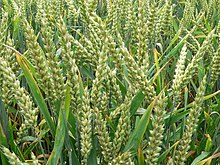Flour


Flour is grains that have been dried and ground into powder. It is usually made of wheat, but can also be made from many other grains, nuts and other substances. Flour is used to make many foods.
Flour is an important part of bread, pasta, cookies, cakes, tortillas. Flour is made in a flour mill where the grain is put between two stones or steel wheels which are rubbed together to make the grains into powder.
The main kinds of flour used in cooking are all-purpose flour, self-raising flour and cake flour. Self-raising flour contains a leavening agent. This makes the food rise (expand) during baking.[1] It produces lighter and softer baked foods by creating small bubbles. Flour that does not have a leavening agent is called all-purpose flour, or plain flour.[2]
Flour can also be made at home. Some people like to make flour at home because when flour comes from the factory, the outer shells of the grains have usually been removed. The outer shells have fiber, which people need to eat for good health. Flour has many nutrients that are good to eat. People can also make flour with things such as pumpkins, pumpkin seeds, brown and white rice, wheat, etc.
History
[change | change source]
It was discovered around 6000 BC that wheat seeds could be crushed between simple millstones to make flour.[3] The Romans were the first to grind seeds on cone mills. Most mills were driven by wind (windmills) or water. Later, they were driven by steam.[4] In the 1930s, some flour began to be enriched with iron, niacin, thiamine and riboflavin. In the 1940s, mills started to enrich flour and folic acid was added to the list in the 1990s.
Related pages
[change | change source]References
[change | change source]- ↑ "What is self-rising flour?". Baking Bites. 2 August 2007.
- ↑ Priya Johnson (29 August 2012). "Self-rising Flour Vs. All-purpose Flour". Buzzle. Archived from the original on 19 January 2013. Retrieved 24 January 2014.
- ↑ Archaeo News Archived 2010-09-01 at the Wayback Machine -Source: Eurasianet.org (2008-12-9); Published 2008-12-14
- ↑ [1] Archived 2011-04-04 at the Wayback Machine -History of flour
Other websites
[change | change source] Media related to Flour at Wikimedia Commons
Media related to Flour at Wikimedia Commons
